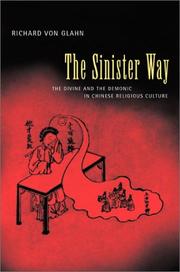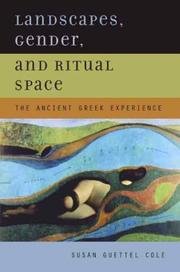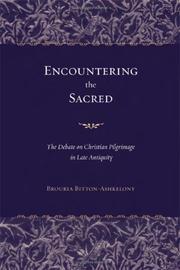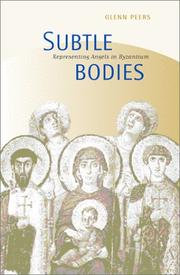| Listing 1 - 10 of 14 | << page >> |
Sort by
|
Book
ISBN: 1283142872 9786613142870 1443830313 9781443830317 9781283142878 9781443828574 1443828572 Year: 2011 Publisher: Newcastle upon Tyne Cambridge Scholars
Abstract | Keywords | Export | Availability | Bookmark
 Loading...
Loading...Choose an application
- Reference Manager
- EndNote
- RefWorks (Direct export to RefWorks)
The fundamental nature of the tree as a symbol for many communities reflects the historical reality that human beings have always interacted with and depended upon trees for their survival. Trees provided one of the earliest forms of shelter, along with c
Trees --- Folk religion --- Religion --- Religious aspects. --- History.
Book
ISBN: 9781608338849 1608338843 9781626984219 Year: 2021 Publisher: Maryknoll, New York
Abstract | Keywords | Export | Availability | Bookmark
 Loading...
Loading...Choose an application
- Reference Manager
- EndNote
- RefWorks (Direct export to RefWorks)
"This breathtakingly beautiful, scholarly, and thought-provoking book is basically about one thing: doing justice to the incarnation. It is the doctrine that confesses not only that God became human, but that God became flesh, became material, thereby signifying the holiness of all God's creation. It is with this conviction that Antonio Sison embarks on a quest to 'midwife' the 'indigenous inculturation' present in a triptych of images from the 'folk Catholic imaginary' in Nairobi in Kenya, Chicago in the United States, and Manila in the Philippines. His purpose is, with a rich hermeneutic of suspicion, generosity, and serendipity, to bring the edges of theologizing to the center. In doing so, however, he reveals to us that, instead of a new theological hegemony (marginal replacing the center), the edges are actually the center." -- From the Foreword by Stephen B. Bevans, SVD
Christianity and culture. --- Christian art and symbolism --- Folk religion. --- Folk art --- Themes, motives.
Book
ISBN: 128301677X 9786613016775 9882205518 9789882205512 9789888028030 9888028030 9789888028047 9888028049 9882205526 Year: 2010 Publisher: Hong Kong
Abstract | Keywords | Export | Availability | Bookmark
 Loading...
Loading...Choose an application
- Reference Manager
- EndNote
- RefWorks (Direct export to RefWorks)
Over the last 40 years, our vision of Chinese culture and history has been transformed by the discovery of the role of religion in Chinese state-making and in local society. The Daoist religion, in particular, long despised as ""superstitious,"" has recovered its place as ""the native higher religion."" But while the Chinese state tried from the fifth century on to construct an orthodoxy based on Confucianism, Daoism, and Buddhism, local society everywhere carved out for itself its own geomantically defined space and organized itself around local festivals in honor of gods of its own choosing-
Religion and state --- Folk religion --- Religion --- China --- Religion. --- Religious life and customs. --- S13A/0200 --- China: Religion--General works
Book
ISBN: 9789048553846 9789463726658 Year: 2023 Publisher: Amsterdam
Abstract | Keywords | Export | Availability | Bookmark
 Loading...
Loading...Choose an application
- Reference Manager
- EndNote
- RefWorks (Direct export to RefWorks)
Mahasu is the joint name of four gods whose influence is widespread throughout the Indian states of Himachal Pradesh and Uttarakhand. Like other deities in the Western Himalayas, they are regarded as royal gods who rule over territories and people. This book traces changes in faith and practices surrounding the Mahasu brothers, and shows how the locals understand these changes by emphasizing the dominant role of humans in the decisions of the gods. The locals are also constantly testing the authenticity of the human mediumship. Thus, the book presents the claim that the gap between local conceptions of divinity and the perceptions of anthropologists regarding gods may be narrower than we think. The Biography of a God: Mahasu in the Himalayas is based on ethnographic research, resulting in an important contribution to the study of Indian village deities, Himalayan Hinduism, lived Hinduism, and the anthropology of religion.
Anthropology. --- Deities, agency, Western Himalaya. --- Folk religion --- Hindu gods --- Hindu mythology --- Folklore --- Himachal Pradesh (India) --- Religious life and customs.

ISBN: 9786612356834 0520928776 1282356836 1597349011 9780520928770 141752555X 9781417525553 0520234081 9780520234086 Year: 2004 Publisher: Berkeley University of California Press
Abstract | Keywords | Export | Availability | Bookmark
 Loading...
Loading...Choose an application
- Reference Manager
- EndNote
- RefWorks (Direct export to RefWorks)
The most striking feature of Wutong, the preeminent God of Wealth in late imperial China, was the deity's diabolical character. Wutong was perceived not as a heroic figure or paragon of noble qualities but rather as an embodiment of humanity's basest vices, greed and lust, a maleficent demon who preyed on the weak and vulnerable. In The Sinister Way, Richard von Glahn examines the emergence and evolution of the Wutong cult within the larger framework of the historical development of Chinese popular or vernacular religion-as opposed to institutional religions such as Buddhism or Daoism. Von Glahn's study, spanning three millennia, gives due recognition to the morally ambivalent and demonic aspects of divine power within the common Chinese religious culture.
Demonology --- Demonology, Christian --- Demons --- Evil spirits --- Spirits --- Spiritual warfare --- History. --- China --- Religion. --- afterlife. --- ancestors. --- ancient china. --- china. --- chinese history. --- chinese jia jiao. --- chinese religion. --- christianity. --- comparative religions. --- cult. --- death. --- deity. --- demon. --- demonic. --- demonology. --- demons. --- divine power. --- divinity. --- folk belief. --- folk religion. --- folklore. --- ghosts. --- goblins. --- god of wealth. --- gods. --- greed. --- han cult. --- imperial china. --- lust. --- nonfiction. --- popular religion. --- possession. --- religion. --- religious culture. --- salvific religion. --- shanxiao. --- sin. --- spirit of the dead. --- spirituality. --- supernatural. --- vernacular religion. --- vice. --- wutong cult. --- wutong.
Book
ISBN: 1283277506 9786613277503 0520948246 9780520948242 9781283277501 9780520259270 0520259270 9780520267527 0520267524 6613277509 Year: 2011 Publisher: Berkeley University of California Press
Abstract | Keywords | Export | Availability | Bookmark
 Loading...
Loading...Choose an application
- Reference Manager
- EndNote
- RefWorks (Direct export to RefWorks)
"Today on Oprah," intoned the TV announcer, and all over America viewers tuned in to learn, empathize, and celebrate. In this book, Kathryn Lofton investigates the Oprah phenomenon and finds in Winfrey's empire-Harpo Productions, O Magazine, and her new television network-an uncanny reflection of religion in modern society. Lofton shows that when Oprah liked, needed, or believed something, she offered her audience nothing less than spiritual revolution, reinforced by practices that fuse consumer behavior, celebrity ambition, and religious idiom. In short, Oprah Winfrey is a media messiah for a secular age. Lofton's unique approach also situates the Oprah enterprise culturally, illuminating how Winfrey reflects and continues historical patterns of American religions.
Celebrities. --- Religion and culture --- Popular culture --- Celebrities --- Religious aspects --- ambition. --- american history. --- american religion. --- american religiosity. --- capitalism. --- celebrity studies. --- celebrity worship. --- celebrity. --- christianity. --- consumer behavior. --- empathy. --- evangelicalism. --- folk religion. --- gender studies and sexuality. --- harpo productions. --- media studies. --- messiah. --- modern religion. --- nonfiction. --- o magazine. --- oprah winfrey. --- oprah. --- philosophy. --- popular culture. --- popular religion. --- psychology. --- religion. --- religious idiom. --- religious studies. --- secular age. --- social history. --- sociology. --- spiritual center. --- spirituality. --- television.
Book
ISBN: 9781906876524 1906876525 9786613663368 9004212604 1280686421 9789004212602 9781280686429 6613663360 Year: 2011 Publisher: Folkestone, Kent, UK
Abstract | Keywords | Export | Availability | Bookmark
 Loading...
Loading...Choose an application
- Reference Manager
- EndNote
- RefWorks (Direct export to RefWorks)
Focuses on traditional monster art and its links to post-war animation, sequential art, and Japanese cinema by adapting Western art historical concepts and methodology.
Comic books, strips, etc. --- Animated films --- Motion pictures --- Monsters in art. --- Art, Japanese --- Bandes dessinées --- Dessins animés --- Cinéma --- Monstres dans l'art --- Art japonais --- History. --- Histoire --- J1723 --- J4150 --- J6030 --- J6200 --- J5960 --- J6839 --- Japan: Religion in general -- primitive religions -- general popular beliefs and folk religion --- Japan: Sociology and anthropology -- customs, folklore and culture --- Japan: Art and antiquities -- themes, symbolism and iconography --- Japan: Art and antiquities -- painting and drawing --- Japan: Literature -- modern fiction and prose -- manga --- Japan: Media arts and entertainment -- cinema --- J6848 --- Japan: Media arts and entertainment -- anime --- Comic books, strips, etc --- Monsters in art --- Monoha (Group of artists) --- Animated cartoons (Motion pictures) --- Animated videos --- Cartoons, Animated (Motion pictures) --- Motion picture cartoons --- Moving-picture cartoons --- Caricatures and cartoons --- Abstract films --- Animation (Cinematography) --- Animation cels --- History and criticism --- History --- History and criticism.

ISBN: 0520929322 9786612356933 1282356933 1597346993 9780520929326 9781597346993 141754502X 9781417545025 0520235444 9780520235441 9781282356931 Year: 2004 Publisher: Berkeley, Calif. University of California Press
Abstract | Keywords | Export | Availability | Bookmark
 Loading...
Loading...Choose an application
- Reference Manager
- EndNote
- RefWorks (Direct export to RefWorks)
The division of land and consolidation of territory that created the Greek polis also divided sacred from productive space, sharpened distinctions between purity and pollution, and created a ritual system premised on gender difference. Regional sanctuaries ameliorated competition between city-states, publicized the results of competitive rituals for males, and encouraged judicial alternatives to violence. Female ritual efforts, focused on reproduction and the health of the family, are less visible, but, as this provocative study shows, no less significant. Taking a fresh look at the epigraphical evidence for Greek ritual practice in the context of recent studies of landscape and political organization, Susan Guettel Cole illuminates the profoundly gendered nature of Greek cult practice and explains the connections between female rituals and the integrity of the community. In a rich integration of ancient sources and current theory, Cole brings together the complex evidence for Greek ritual practice. She discusses relevant medical and philosophical theories about the female body; considers Greek ideas about purity, pollution, and ritual purification; and examines the cult of Artemis in detail. Her nuanced study demonstrates the social contribution of women's rituals to the sustenance of the polis and the identity of its people.
Sacred space --- Women --- Holy places --- Places, Sacred --- Sacred places --- Sacred sites --- Sacred spaces --- Sites, Sacred --- Space, Sacred --- Holy, The --- Religion and geography --- Human females --- Wimmin --- Woman --- Womon --- Womyn --- Females --- Human beings --- Femininity --- History. --- Religious life --- Artemis --- Αρτεμις --- أرتميس --- Ārtimīs --- Artemisa --- Artemida --- Артэміда --- Артемида --- Artemiso --- 아르테미스 --- Arŭt'emisŭ --- Artemide --- ארטמיס --- Artemi --- Artemisz --- アルテミス --- Артеміда --- 阿耳忒弥斯 --- A'ertemisi --- Diana --- Cult. --- Greece --- Religious life and customs. --- Artemis (Greek deity) --- Religion. --- Women -- Religious life -- Greece -- History.. --- Sacred space -- Greece -- History.. --- Artemis (Greek deity) -- Cult.. --- Greece -- Religion. --- ancient history. --- ancient law. --- anthropology. --- antiquity. --- arete. --- artemis. --- athenian democracy. --- city states. --- community. --- competition. --- family. --- female body. --- feminism. --- fertility. --- folk religion. --- folklore. --- gender difference. --- gender roles. --- gender. --- greece. --- greek ritual. --- greeks. --- hubris. --- law. --- legal system. --- masculinity. --- mythology. --- nonfiction. --- polic. --- pollution. --- purity. --- religion. --- reproduction. --- rite. --- ritual. --- sacred space. --- sexuality. --- social body. --- tradition. --- violence. --- women. --- womens rituals.

ISBN: 1282357522 0520931122 9786612357527 1598759256 9780520931121 1423745450 9781423745457 9780520241916 0520241916 9781282357525 6612357525 9781598759259 Year: 2005 Publisher: Berkeley University of California Press
Abstract | Keywords | Export | Availability | Bookmark
 Loading...
Loading...Choose an application
- Reference Manager
- EndNote
- RefWorks (Direct export to RefWorks)
This innovative study sheds new light on one of the most spectacular changes to occur in late antiquity-the rise of pilgrimage all over the Christian world-by setting the phenomenon against the wide background of the political and theological debates of the time. Asking how the emerging notion of a sacred geography challenged the leading intellectuals and ecclesiastical authorities, Brouria Bitton-Ashkelony deftly reshapes our understanding of early Christian mentalities by unraveling the process by which a territory of grace became a territory of power. Examining ancient writers' responses to the rising practice of pilgrimage, Bitton-Ashkelony offers a nuanced reading of their thinking on the merits and the demerits of pilgrimage, revealing theological and ecclesiastical motivations that have been overlooked, and questioning the long-held assumption of scholars that pilgrimage was only a popular, not an elite, religious practice. In addition to Greek and Latin sources, she includes Syriac material, which allows her to build a rich picture of the emerging theology of landscape that took shape over the fourth to sixth centuries.
Christian pilgrims and pilgrimages --- Pilgrims and pilgrimages, Christian --- Christian shrines --- Pilgrims and pilgrimages --- History of doctrines --- Palestine --- Holy Land --- In Christianity --- Palestine in Christianity --- Christianity --- Christian pilgrims and pilgrimages -- Palestine -- History of doctrines -- Early church, ca. 30-600.. --- Palestine in Christianity -- History of doctrines -- Early church, ca. 30-600. --- Christian pilgrims and pilgrimages - Palestine - History of doctrines - Early church, ca. 30-600 --- Palestine in Christianity - History of doctrines - Early church, ca. 30-600 --- Pèlerinages --- Antiquité tardive --- ancient world. --- antiquity. --- aristocracy. --- augustine. --- bible. --- christian pilgrims. --- christian world. --- christianity. --- class. --- cloister. --- early church. --- elite religion. --- folk religion. --- grace. --- gregory of nyssa. --- holiness. --- holy land. --- holy men. --- holy sites. --- holy space. --- jerome. --- jerusalem. --- landscape. --- monasteries. --- monasticism. --- monks. --- monuments. --- nonfiction. --- nuns. --- palestine. --- pilgrimage. --- pilgrims. --- popular religion. --- relics. --- religion. --- religious devotion. --- religious practices. --- sacred geography. --- sacred space. --- saints. --- theology. --- tombs. --- travel. --- worship.

ISBN: 9786612356308 0520925130 1282356305 1597349240 9780520925137 1417523840 9781417523849 9780520224056 0520224051 9781597349246 6612356308 0520224051 9781282356306 Year: 2001 Publisher: Berkeley University of California Press
Abstract | Keywords | Export | Availability | Bookmark
 Loading...
Loading...Choose an application
- Reference Manager
- EndNote
- RefWorks (Direct export to RefWorks)
Throughout the course of Byzantine history, Christian doctrine taught that angels have a powerful place in cosmology. It also taught that angels were immaterial, bodiless, invisible beings. But if that were the case, how could they be visualized and depicted in icons and other works of art? This book describes the strategies used by Byzantine artists to represent the incorporeal forms of angels and the rationalizations in defense of their representations mustered by theologians in the face of iconoclastic opposition. Glenn Peers demonstrates that these problems of representation provide a unique window on Late Antique thought in general.
Church history --- Angels in literature. --- Angels in art. --- Angels --- Iconoclasm --- Christianity --- Angels (Buddhism) in art --- Idols and images --- Biblical teaching. --- History. --- Middle Ages, 600-1500 --- History --- Worship --- Orthodox Eastern Church --- Byzantine Empire --- Church history. --- Orthodox Eastern Church -- Byzantine Empire -- History.. --- Iconoclasm -- Byzantine Empire -- History.. --- Angels -- Biblical teaching.. --- Angels in art.. --- Angels in literature.. --- Church history -- Middle Ages, 600-1500.. --- Byzantine Empire -- Church history. --- aesthetics. --- ancient world. --- angels in art. --- angels in literature. --- angels. --- archangel. --- art. --- barberini diptych. --- bible. --- bodies. --- byzantine art. --- byzantium. --- cherub. --- cherubim. --- church doctrine. --- divinity. --- early christian theology. --- early church. --- embodiment. --- folk belief. --- folk religion. --- greece. --- hagiography. --- hellenism. --- iconoclasm. --- icons. --- literature. --- madonna. --- magritte. --- michael. --- middle ages. --- religion. --- religious practices. --- saints legends. --- saints lives. --- saints. --- sarcophagus. --- theology. --- unrepresentable. --- virgin and child.
| Listing 1 - 10 of 14 | << page >> |
Sort by
|

 Search
Search Feedback
Feedback About UniCat
About UniCat  Help
Help News
News